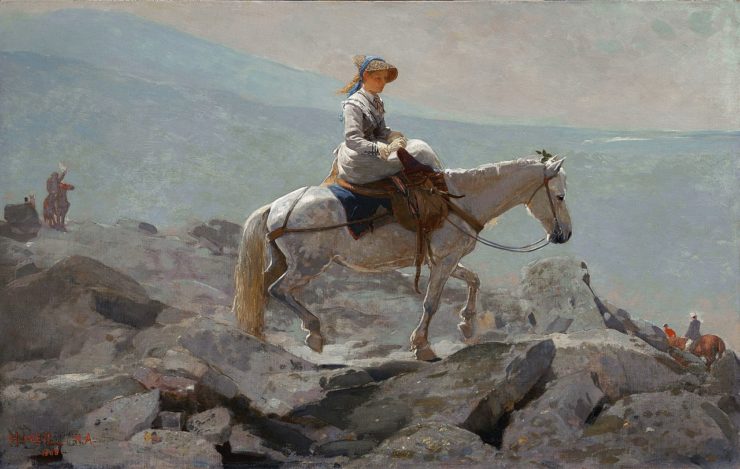As often happens when I’m coming up with topics for this series, the universe has obliged by offering just the thing. Commenters on my other series, the Andre Norton Reread, got to talking about the cover of one of her books, which features a woman on a horse. The horse is wearing a bridle without a noseband, which led to questions about what kind of headstall it is, and is it a bridle or is it something else?
Bridles and headstalls, like saddles, are rock-solid basics in the horse world. There are people who ride without anything on the horse’s head, either Gandalf-style with no tack at all, or with some form of rope or wire around the horse’s neck or chest. For the most part however, when a human wants to control the horse, they do it by controlling the head.
The horse’s anatomy has a lot to do with it. The actual engine is in the rear, and the horse moves from back to front, but the head and its structures are highly sensitive and responsive to pressure. A rope around any other part of the horse won’t have much effect, but get one behind the ears and around the nose and you’ve seriously upped your game. Add a bar of metal, wood, bone, whatever, or even a strip of leather or rope in the mouth and attach that to a set of reins, and you’ve more than evened out the difference in size and strength between a horse and a human.
The first humans who domesticated the horse seem to figured this out very early on. One metric archaeologists have used to determine when horses were used as transport is bit wear on the teeth. This has been called into question, but it tells you how important the concept of bit and bridle is to the history of the horse.
Long before a horse actually wears a bit, if they do, they will be trained to wear a halter or headcollar. One of the first things a trainer does with a foal or young horse is to teach them to wear a halter and be led by a rope or strap attached to it. A horse who is not halter-broke lacks the most essential skill for domesticated life. Without that skill, they can’t be led or tied, and while they may be herded into whatever space they need to be in, there’s no simple way to control them.
Buy the Book


All the Horses of Iceland
A halter is a fairly straightforward piece of equipment. It has a part that goes behind the ears and a part that goes around the nose. If there’s no constructed version handy, a horse person can rig one with couple of pieces of hay twine and a strategic knot. I’ve even been known to grab a polo wrap (a long strip of woven fabric or fleece, used as a wrap to protect the legs during training) and improvise with a loose horse and no halter handy.
The difference between a halter and a bridle can get fuzzy in places. A bridle will almost always have the strap behind the ears, though it may not have the noseband—the bit and reins will hold it in place, and often there’s a browband or an ear slit to keep it from slipping off. It is possible to ride in a halter and rope, with or without a bit attached, and there are bitless bridles of various designs.
Bitless bridles operate though pressure on the horse’s crown and poll, or on the nose, or both. There is a fair amount of propaganda involved, leaning heavily on the pain and coercion of the bit and the purported gentleness of the alternative, but pressure is pressure, and when misapplied, it may actually be more painful than the bit it’s meant to replace.
The basic principle of the bridle (with reins included) is to control the horse. Different styles of riding approach that in different ways. Dressage, for example, regards the bit as a support mechanism, like the barre in ballet. The rider is taught to keep a steady contact through the reins, inviting the horse to move forward into the bit. Done correctly, it’s soft, light, and very much alive, and there’s constant communication between the horse and the rider.
Western riding on the other hand treats the bit more as a boundary. Steering relies on the touch of the rein on the neck. The bit regulates speed both forward and back, and signals a halt. In between, the rider stays off the mouth.
The English bridle (including dressage, which isn’t precisely “English” but it’s in that continuum) usually has a noseband and always has a browband. Some of that is tradition. Some is engineering. A browband keeps the crown piece from slipping out of place. A noseband can stabilize the structure of the bridle and the position of the bit, sometimes passively by sitting up above the bit, sometimes actively by fitting over or around the bit and holding it in place.
The Western bridle tends not to include a noseband and may dispense with a browband as well. If there is something over the nose, it may be a halter intended for tying out the horse on the trail, or there may be no bit and the “noseband” is the leverage mechanism of the bridle, for example the stiff loop of the bosal or the mechanical construction of the hackamore. The bridle itself may be richly tooled and ornamented but its structure is quite simple, a strap over the poll, a bit, a set of reins. It shows off a pretty head to advantage.
As for the bit, there’s a wide range and variety of designs, structures, and levels of control. Basically, the thinner the part that goes in the mouth, the more severe pressure it puts on the tongue and the lips; and yes, that translates as pain. Likewise, if the bit has shanks extending down the sides, the longer the shanks, the greater the leverage.
Leverage is control. It does not have to be pain. It can enhance precision in very advanced styles of riding, communicating subtle nuances to the trained horse. But that requires a highly trained rider or driver, and great skill. Bits of this style are not meant to be leaned on. A quick touch, then let go. Never yank or snatch.
The gentlest bit is one with a ring but no shanks, and it may be jointed in the middle—though that in the wrong hands can turn into a nutcracker. There’s much less control over the horse with such a bit; they can bull through it, and will if the rider lacks skill or finesse. Horses with bulldozer tendencies often end up in leverage bits for the rider’s health and safety.
For the writer or artist who is not a horse person but needs to depict horses in their work, the main thing is to know the difference between a halter and a bridle, and to understand the basic principle and the working parts of each. A halter is for leading and tying. A bridle is for riding or driving. The halter doesn’t have a lot of nuance to it—you can control speed to a degree, and signal stop and go, but if you want real control and actual precision, that’s what a bridle is for.
As for the style of bridle, that depends on the setting. You won’t see a hackamore in medieval France. A full dressage bridle with two bits and two sets of reins would be out of place in the American West (though there would be ways to make that work). Different styles serve different functions. The design and construction will vary according to the style, and the parts and the way they fit together will vary as well. There’s not usually any need to go into detail, but it can be helpful to know a few basic terms.
Even in a fantasy world, these principles would apply. If you know what your horse needs to do, and how they need to do it in that particular setting, you can find a real-world analogue to base your fictional bridle on.
Judith Tarr is a lifelong horse person. She supports her habit by writing works of fantasy and science fiction as well as historical novels, many of which have been published as ebooks. She’s written a primer for writers who want to write about horses: Writing Horses: The Fine Art of Getting It Right. She lives near Tucson, Arizona with a herd of Lipizzans, a clowder of cats, and a blue-eyed dog.










